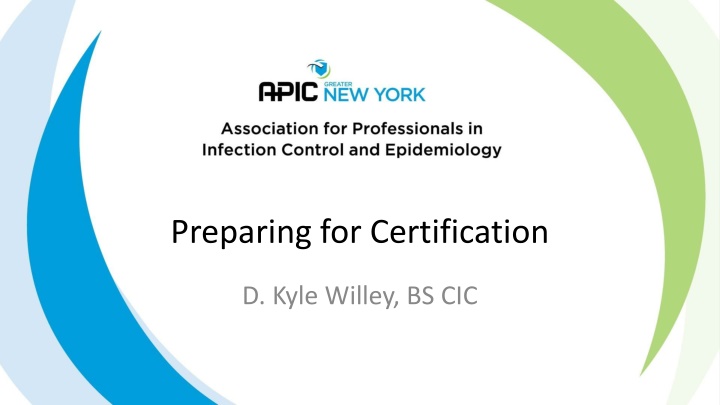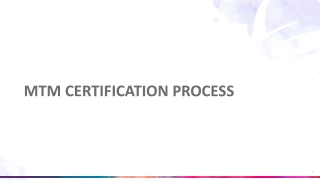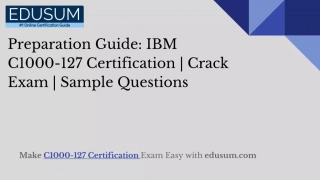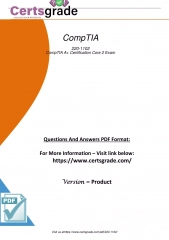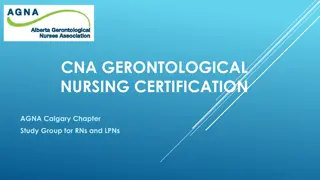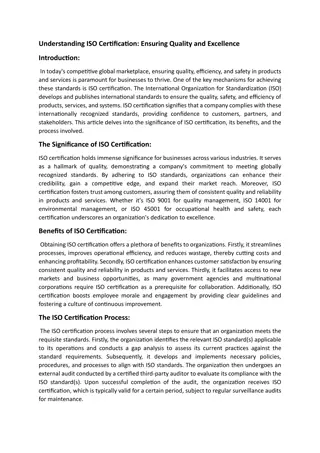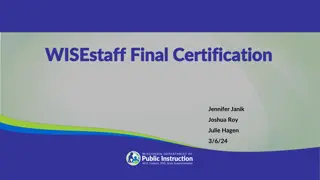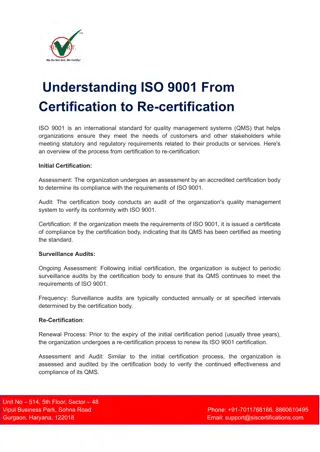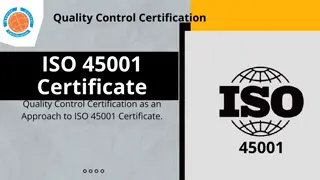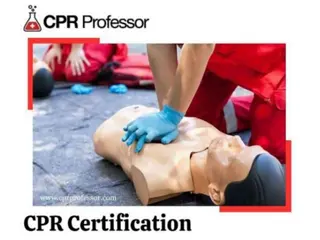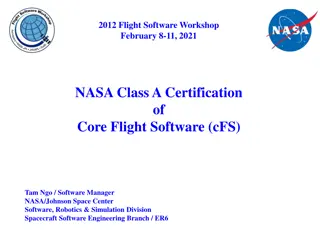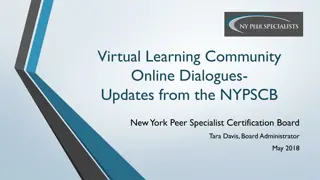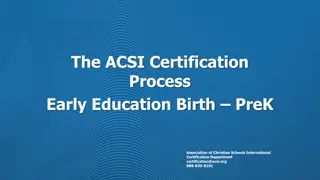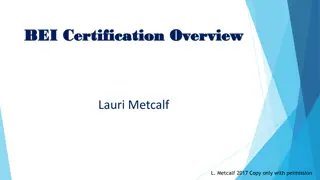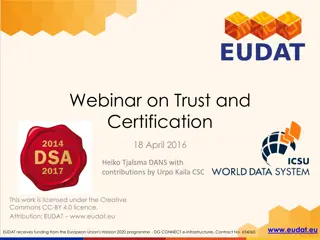Preparing for Certification
This content provides a detailed breakdown of the topics covered in a certification exam for infectious disease control. It includes sections on identification of infectious disease processes, surveillance and epidemiologic investigation, preventing and controlling transmission of infectious agents, employee and occupational health, as well as management and communication in the field.
Download Presentation

Please find below an Image/Link to download the presentation.
The content on the website is provided AS IS for your information and personal use only. It may not be sold, licensed, or shared on other websites without obtaining consent from the author.If you encounter any issues during the download, it is possible that the publisher has removed the file from their server.
You are allowed to download the files provided on this website for personal or commercial use, subject to the condition that they are used lawfully. All files are the property of their respective owners.
The content on the website is provided AS IS for your information and personal use only. It may not be sold, licensed, or shared on other websites without obtaining consent from the author.
E N D
Presentation Transcript
Preparing for Certification D. Kyle Willey, BS CIC
What is on the Exam? Identification of Infectious Disease Processes (22 items) Interpret diagnostic and laboratory reports Practices for specimen collection, handling, and storage Correlate clinical s/s with infectious disease processes Differentiate colonization, infection, and contamination Differentiate prophylactic, empiric, and therapeutic uses of antimicrobials
What is on the Exam? Surveillance and Epidemiologic Investigation (24 items) Design of Surveillance Systems Collection and Compilation of Surveillance Data Interpretation of Surveillance Data Outbreak Investigation
What is on the Exam? Preventing/Controlling the Transmission of Infectious Agents (25 items) Develop evidence-based/informed infection prevention and control policies and procedures Collaborate with relevant groups and agencies in planning community/facility responses to biologic threats and disasters Identify and implement infection prevention and control strategies
What is on the Exam? Employee/Occupational Health (11 items) Develop screening and immunization programs Evaluate data and develop work restriction recommendations related to communicable diseases and/or exposures Recognize healthcare personnel who may represent a transmission risk to patients, coworkers, and communities Assess risk of occupational exposure to infectious diseases (e.g., Mycobacterium tuberculosis, bloodborne pathogens)
What is on the Exam? Management and Communication (13 items) Infection Prevention program planning Communication and Feedback Evaluate and facilitate compliance with accreditation standards/regulatory requirements Quality Performance Improvement and Patient Safety
What is on the Exam? Education and Research (11 items) Education Assess needs, develop goals and measurable objectives Prepare, present, or coordinate educational content that is appropriate for the audience Research Conduct a literature review Critically appraise the literature Facilitate incorporation of applicable research findings into practice
What is on the Exam? Environment of Care (14 items) Elements important for a safe care environment Assess infection risks of design, construction, and renovation Evaluation and monitoring of environmental cleaning and disinfection Selection and evaluation of environmental disinfectant products
What is on the Exam? Cleaning, Sterilization, Disinfection, Asepsis (15 items) Identify and evaluate appropriate cleaning, sterilization and disinfection practices Collaborate with others to assess products under evaluation for their ability to be reprocessed Identify and evaluate critical steps of cleaning, high level disinfection, and sterilization
Sample Test Questions 1. A facility is establishing a new Infection Control program. Which of the following should be recommended? A. B. C. One Infection Preventionist for every 250 patients Purchase of data management software for surveillance An Infection Prevention and Control Committee that holds monthly meetings An Infectious Disease physician as an program director Discussion: 1. A couple good choices. Any bad/wrong ones? 2. What will give us the most for time/money/effort? D.
Sample Test Questions 2. A form of interactive training is often preferred among adult learners. However, in some situations a lecture may represent the best approach. In which of the following situations should the IP consider using a lecture? A. When reviewing accreditation survey results for the infection prevention program with managers When addressing inaccurate data entry of reportable infections by a health data analyst After observing unsafe disposal of contaminated syringes in the Emergency Department When discovering employees with influenza-like symptoms providing patient care Discussion: 1. What are the pros/cons of a lecture from an Adult Learner standpoint? B. C. D.
3. Adult learners are often motivated to learn by: 1. The need for new skills 2. Professional standard mandates 3. Desire for promotion and increased salary 4. Changing cultural expectations A. 2, 4 B. 1, 3 C. 3, 4 D. 1, 4 Discussion: 1. What are the best/worst motivators for Adult Learners?
Sample Test Questions 4. Which of the following viruses has been associated with the HIGHEST rate of transmission among infants in neonatal nursery settings? Discussion: 1. How are each transmitted? 2. What risk factors are involved? A. herpes simplex virus B. cytomegalovirus (CMV) C. Coxsackievirus D. respiratory syncytial virus
Sample Test Questions 5. A case of which of the following situations warrants immediate investigation by the infection preventionist (IP)? A. H. influenza pneumonia in a patient in the Medical Unit conjunctivitis in a patient following eye surgery Legionella pneumonia in a patient in the Oncology Unit norovirus in a patient in the Emergency Department Discussion: 1. All require attention, what is MOST IMMEDIATE? 2. Can we rule out any? B. C. D.
Sample Test Questions 6. An infection preventionist (IP) is developing a post-discharge surveillance program for surgical site infections. A review of the literature on the subject should indicate which of the following? A. There are published standard methods for conducting post-discharge surveillance. More than 50% of surgical site infections may be missed without a formal post-discharge surveillance system in place. Post-discharge surveillance that solicits direct feedback from patients yields data with the best specificity and sensitivity to identify true infection. The trend of shorter length of stay has not significantly impacted the rate of surgical site infections identified through inpatient surveillance programs. Discussion: 1. What risk factors are involved? B. C. D.
Sample Test Questions 7. An infection preventionist (IP) noted an increase in sternal surgical site infections (SSIs) following CABG procedures performed in the IP's facility during the past four quarters. Which of the following should be reviewed by the IP in conjunction with the interdisciplinary team? A. infusion of vancomycin mean duration = 90 minutes discontinuation of antibiotics 24 hours after surgery mean glucose readings 6 AM day 2 postoperative = 120 mg/dL (6.7 mmol/L) shaving the site 1 hour before surgery Discussion: 1. Are there any we can exclude? 2. What is correct for these? B. C. These all used to be the SCIP measures we stopped measuring in 2014 or so. D.
Sample Test Questions 8. An agency employing 230 homecare nurses reported eight needlestick injuries resulting from the use of lancets in spring-loaded devices. The FIRST intervention should be to Discussion: 1. Are there any we know that we can exclude? A. B. design a poster on lancet use for each work site meet with the nurses individually to determine circumstances contributing to the injuries distribute the nurses' injury reports describing the circumstances of their injuries to the rest of the nursing staff call the manufacturer to report a product defect C. D.
Sample Test Questions 8 (Follow-up). Which foodborne illness outbreaks of the following are most attributed to? Salmonella Salmonella, Campylobacter, C. perfringens, E.coli A. B. C. D. E. Using non-pasteurized eggs in salad dressing Rinsing raw chicken prior to preparation Not rinsing raw vegetables Can openers Deli slicers Hepatitis A, E.coli, Listeria Mold, yeast, E.coli Listeria 3rd highest deaths
